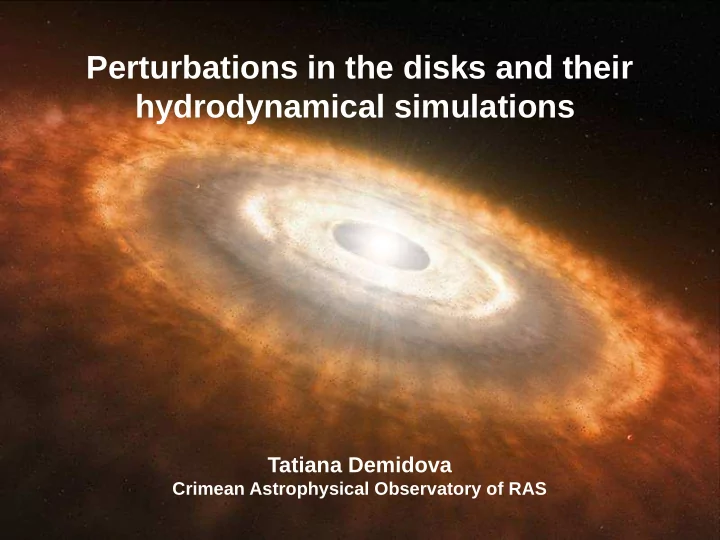

Perturbations in the disks and their hydrodynamical simulations Tatiana Demidova Crimean Astrophysical Observatory of RAS
The cyclic activity of UX Ori type stars Grinin et al. (1991) Grinin et al. (2010) Rostopchina et al. (2007) Shahkovskoi et al., (2005)
3D hydrodynamic simulations with SPH method Herbig Ae star Companion q = M : M = 0.1 - 0.003 2 1 e = 0.0 0.3 Protoplanetary disk 5 N = 2 5 10
The model where the companion orbit misaligned with the disk plane: Grinin et al. 2010 i = 0 30 i Previous paper: Larwood and Papaloizou (1997) explained the tilt of the inner part in β Pic disk.
The calculation of the column density Sotnikova & Grinin (2007); Demidova et al. (2010); Grinin et al. (2010) Azimuth angle of the line of sight from x axis with a step 45 ° . The inclination — from disk plane with a step 5 °.
The structures in the common disk The surface density in the disk The spiral structures in the inner part of the common disk The homogeneous periphery of the common disk The surface density at the fixed radius in dependence of the azimuth angle
The circumstellar and companion disk inside the sublimation radios of dust
Results Grinin et al. (2008) Grinin et al. (2010); Demidova et al. (2010) V718 Per (H 187) Shahkovskoi et al. (2005) ; Demidova et al. (2010) Rostopchina et al. (2006); Demidova et al. (2010)
The density waves in the circumstellar disk (model q = 0.1, e = 0.3, i = 5°): Two spiral arms arise when the companion pass by the pericenter and its disappear after the companion pass by the apocenter. Similar results: Nelson (2000); Kley & Nelson (2008)
The column density in the circumstellar disk (model q = 0.1, e = 0.3, i = 0°, θ = 10°): 10̊ is the maximum inclination where the noticeable number of particles lies on the line of sight for the model with the companion orbit coplanar to the disk plane.
The precession of the circumstellar disk (model q = 0.1, e = 0.3, i = 5°,φ = 0̊, θ = 10°):
The precession of the circumstellar disk (model q = 0.1, e = 0.3, i = 5°,φ = 0̊, θ = 10°):
The idea about asymmetric illumination of the outer part disk: Demidova et al. (2013); Demidova & Grinin (2014) Warm area are illuminated Cold area are shielded by the direct stellar radiation by the warped disk
The disk surface definition Scattering layer Disk surface Surface density Vertical density distribution Optical depth k – Opacity Natta & Whitney (2000)
The calculation of the disks images Tambovtseva et al. (2006); Demidova & Grinin (2014) Direct radiation Scattered light Temperature Luminosity
Tuthill et al. (2002) Demidova et al. (2014)
Collaboration with S.Wolf group Method – the Monte Carlo-based full 3D continuum radiative transfer code MC3D (Wolf 2003; Wolf et al. 1999). Dust – spherical dust grains: 62.5% silicate, 37.5% graphite density of dust: 2.5 n(a) a dust grain size distribution: a [ 0.005 μm, 100 μm] Ice is not considered. Secondary component Primary component – Herbig Ae star mass: M = 2 luminosity: L = 43 temperature: T = 9500 K Semimajor axis of the component orbit a = 2 AU
The temperature distribution in the inclined model Temperature maps along vertical cuts through the density distributions of the disk model with the parameters: q = 0.1 , i = 30̊ , e = 0
The comparison of the images in IR and radiowaves in the inclined model: Ruge et al. 2015 λ = 740 μm λ = 2.2 μm The images in IR band show the inner warm part of the disk, but the radio images can demonstrate the outer part of the disk. Disk is optically thin in radio waves and warm region shielded from an observer can shine through the disk. The “butterfly”-shaped images can be observed. Similar results: Arzamasskiy et al. (2018); Zhu (2018).
Predicted images with ALMA for the inclined models q = 0.1 q = 0.01 If q = 0.1 the simulated observations appear as rings at low inclinations. This aspect is destroyed if i > 10° . If q = 0.01 the perturbations induced by the component into the disk are not strong enough to be detected in the simulated observations.
Quasi-stationary shadow on the disk HD 135344B, Stolker et al. (2017)
Conclusions Signature of an invisible low-mass companion: 1)The cyclic brightness variations of UX Orion type stars; 2) Quasi-stationary shadow on the disk image; 3)“Horseshoe” asymmetry in IR and “butterfly” in a radio image of the disk.
Recommend
More recommend